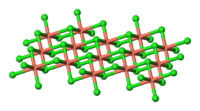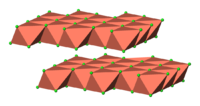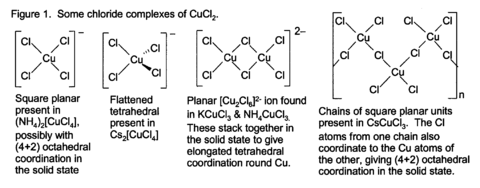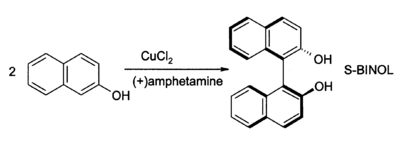Copper(II) chloride
2008/9 Schools Wikipedia Selection. Related subjects: Chemical compounds
| Copper(II) chloride | |
|---|---|
 |
|
 |
|
 |
|
| IUPAC name | Copper(II) chloride Copper dichloride |
| Other names | Cupric chloride |
| Identifiers | |
| CAS number | [7447-39-4] (ahydrous) 10125-13-0] (dihydrate) |
| RTECS number | GL7000000 |
| Properties | |
| Molecular formula | CuCl2 |
| Molar mass | 134.45 g/mol (anhydrous) 170.48 g/mol (dihydrate) |
| Appearance | blue-green solid (dihydrate) yellow-brown solid (anhydrous) |
| Density | 3.386 g/cm³, solid |
| Melting point |
100 °C (dehydration |
| Boiling point |
decomposes at 993°C |
| Solubility in water | 70.6 g/100 mL (0 °C) 75.7 g/100 mL (25 °C) |
| Solubility in ethanol | 53 g/100 mL (15 °C) |
| Structure | |
| Crystal structure | distorted CdI2 structure |
| Coordination geometry |
Octahedral |
| Hazards | |
| MSDS | ScienceLab.com |
| EU classification | not listed |
| Flash point | nonflammable |
| Related compounds | |
| Other anions | Copper(II) fluoride Copper(II) bromide Copper(I) iodide |
| Other cations | Copper(I) chloride Silver chloride Gold(III) chloride |
| Except where noted otherwise, data are given for materials in their standard state (at 25 °C, 100 kPa) Infobox disclaimer and references |
|
Copper(II) chloride is the chemical compound with the formula CuCl2. This a yellow-brown solid which slowly absorbs moisture to form a blue-green dihydrate. It occurs naturally as the very rare mineral eriochalcite.
Structure
Anhydrous CuCl2 adopts a distorted cadmium iodide structure. Most copper(II) compounds exhibit distortions from idealized octahedral geometry due to the Jahn-Teller effect, which in this case describes the localisation of one d-electron into a molecular orbital that is strongly antibonding with respect to a pair of ligands. In CuCl2(H2O)2 the copper can be described as a highly distorted octahedral complex, the Cu(II) centre being surrounded by two water ligands and four chloride ligands, which bridge asymmetrically to other Cu centers.
Properties
Copper(II) chloride dissociates in aqueous solution to give the blue colour of [Cu(H2O)6]2+ and yellow or red colour of the halide complexes of the formula [CuCl2+x]x-. Concentrated solutions of CuCl2 appear green because of the combination of these various chromophores.
It is a weak Lewis acid, and a mild oxidising agent. It has a crystal structure consisting of polymeric chains of flat CuCl4 units with opposite edges shared. It decomposes to CuCl and Cl2 at 1000 °C:
In its reaction with HCl (or other chloride sources) to form the complex ions CuCl3- and CuCl42-.
Some of these complexes can be crystallized from aqueous solution, and they adopt a wide variety structural types (Fig. 1). 
Copper(II) chloride also forms a rich variety of other coordination complexes with ligands such as pyridine or triphenylphosphine oxide:
- CuCl2 + 2 C5H5N → [CuCl2(C5H5N)2] (tetragonal)
- CuCl2 + 2 (C6H5)3P=O → [CuCl2((C6H5)3P=O)2] (tetrahedral)
However "soft" ligands such as phosphines (e.g., triphenylphosphine), iodide, and cyanide as well as some tertiary amines cause reduction to give copper(I) complexes. To convert copper(II) chloride to copper(I) derivatives it is generally more convenient to reduce an aqueous solution with the reducing agent sulfur dioxide:
CuCl2 can simply react as a source of Cu2+ in precipitation reactions for making insoluble copper(II) salts, for example copper(II) hydroxide, which can then decompose above 30 ° C to give copper(II) oxide:
Followed by
- Cu(OH)2( s) → CuO( s) + H2O( l)
Preparation
Copper(II) chloride is prepared by the action of hydrochloric acid on copper(II) oxide, copper(II) hydroxide or copper(II) carbonate, for example:
- CuO( s) + 2 HCl( aq) → CuCl2(aq) + H2O( l) Anhydrous CuCl2 may be prepared directly by union of the elements, copper and chlorine.
CuCl2 may be purified by crystallisation from hot dilute hydrochloric acid, by cooling in a CaCl2-ice bath.
Uses
A major industrial application for copper(II) chloride is as a co-catalyst (along with palladium(II) chloride) in the Wacker process. In this process, ethene (ethylene) is converted to ethanal (acetaldehyde) using water and air. In the process PdCl2 is reduced to Pd, and the CuCl2 serves to re-oxidise this back to PdCl2. Air can then oxidise the resultant CuCl back to CuCl2, completing the cycle.
(1) C2H4(g) + PdCl2(aq) + H2O (l) → CH3CHO (aq) + Pd(s) + 2 HCl(aq)
(2) Pd(s) + 2 CuCl2(aq) → 2 CuCl(s) + PdCl2(aq)
(3) 2 CuCl(s) + 2 HCl(aq) +1/2O2(g) → 2 CuCl2(aq) + H2O(l)
Overall process: C2H4 +1/2O2 → CH3CHO
Copper(II) chloride has a variety of applications in organic synthesis. It can effect chlorination of aromatic hydrocarbons- this is often performed in the presence of aluminium oxide. It is able to chlorinate the alpha position of carbonyl compounds:
This reaction is performed in a polar solvent such as DMF, often in the presence of lithium chloride, which speeds up the reaction rate.
CuCl2, in the presence of oxygen, can also oxidise phenols. The major product can be directed to give either a quinone or a coupled product from oxidative dimerisation. The latter process provides a high-yield synthesis of 1,1-binaphthol (also called BINOL) and its derivatives, these can even be made as a single enantiomer in high enantiomeric excess:
Such compounds are valuable intermediates in the synthesis of BINAP and its derivatives, popular as chiral ligands for asymmetric hydrogenation catalysts.
CuCl2 also catalyses the free radical addition of sulfonyl chlorides to alkenes; the alpha-chlorosulfone may then undergo elimination with base to give a vinyl sulfone product.
Copper(II) chloride is also used in pyrotechnics as a blue/green coloring agent.
Precautions
Although copper is an essential element, all metal salts are potentially toxic if mishandled. See MSDS.


